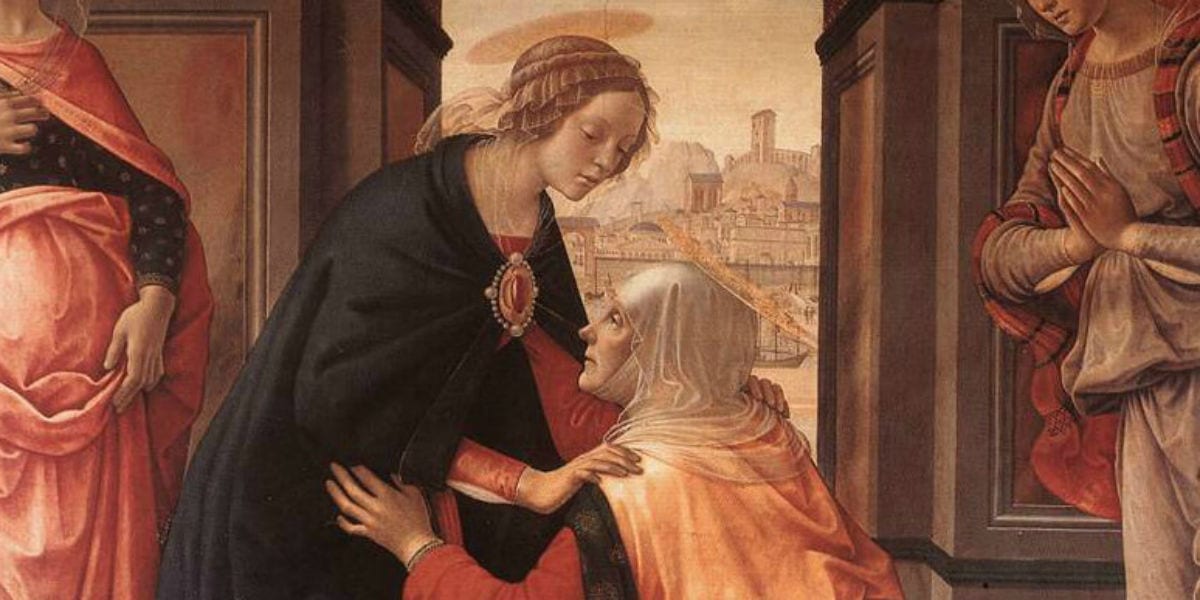Regina Caeli – Queen of Heaven, Rejoice!
The Regina Caeli, Latin for “Queen of Heaven,” is a hymn and prayer ...

Writing in the early 8th century, Bede explains comments on Mary’s Visitation of Elizabeth. He explains why Mary’s Magnificat appears daily in the liturgy of the hours (a.k.a the divine office) for Vespers or evening prayer. With Mary’s soul, our souls magnify the Lord and rejoice in God our Savior.
M y soul proclaims the greatness of the Lord, and my spirit rejoices in God my savior [Luke 1:46]. With these words Mary first acknowledges the special gifts she has been given. Then she recalls God’s universal favors, bestowed unceasingly on the human race.
When a man devotes all his thoughts to the praise and service of the Lord, he proclaims God’s greatness. His observance of God’s commands, moreover, shows that he has God’s power and greatness always at heart. His spirit rejoices in God his savior and delights in the mere recollection of his creator who gives him hope for eternal salvation.
These words are often for all God’s creations, but especially for the Mother of God. She alone was chosen, and she burned with spiritual love for the son she so joyously conceived. Above all other saints, she alone could truly rejoice in Jesus, her savior, for she knew that he who was the source of eternal salvation would be born in time in her body, in one person both her own son and her Lord.
For the Almighty has done great things for me, and holy is his name. Mary attributes nothing to her own merits. She refers all her greatness to the gift of the one whose essence is power and whose nature is greatness, for he fills with greatness and strength the small and the weak who believe in him.
She did well to add: and holy is his name, to warn those who heard, and indeed all who would receive his words, that they must believe and call upon his name. For they too could share in everlasting holiness and true salvation according to the words of the prophet: and it will come to pass, that everyone who calls on the name of the Lord will be saved. This is the name she spoke of earlier: and my spirit rejoices in God my savior.
Therefore it is an excellent and fruitful custom of holy Church that we should sing Mary’s hymn at the time of evening prayer. By meditating upon the incarnation, our devotion is kindled, and by remembering the example of God’s Mother, we are encouraged to lead a life of virtue. Such virtues are best achieved in the evening. We are weary after the day’s work and worn out by our distractions. The time for rest is near, and our minds are ready for contemplation.
For more by St. Bede on the Visitation and on Mary’s great Canticle of Praise, read MARY’S MAGNIFICAT.
Post on the great canticle, the Magnificat, proclaimed by Mary during her Visitation of St. Elizabeth by the Blessed Virgin Mary. This excerpt from a homily by Saint Bede the Venerable (Lib 1,4:CCL 122, 25-26, 30) appears in the Roman Catholic Liturgy’s Divine Office of Readings for the Feast of the Visitation, May 31. The accompanying biblical reading comes from Song of Songs 2:8-14 and 8:6-7. With Mary’s soul, we proclaim the greatness of the Lord and rejoice in God, her Savior and ours, each evening in Vespers prayer.
Banner/featured image Visitation of Elizabeth by the Virgin Mary by Domencio Ghirlandaio. Public domain.
Susan Meeker
Posted at 14:49h, 28 FebruaryWho is represented in the art other than Our Blessed Mother and Saint Elizaboth
Dr. Marcellino D'Ambrosio
Posted at 17:02h, 28 FebruaryThe painting is The Visitation by the Italian early renaissance artist, Domenico_Ghirlandaio (the original painting is on display in Paris at the Louvre). I’m not sure that the artist intended to represent anyone in particular by the two women flanking the Blessed Virgin and St. Elizabeth. They are probably conceived of as random friends, relatives, or servants.